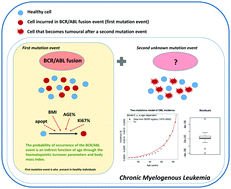Accurate prediction of the age incidence of chronic myeloid leukemia with an improved two-mutation mathematical model
Abstract
Chronic myeloid leukemia (CML) is a malignant clonal disorder whose hallmark is a reciprocal translocation between chromosomes 9 and 22 occurring in 95% of affected patients. This translocation causes the expression of a deregulated BCR/ABL fusion oncogene and, interestingly, is detectable in healthy individuals. Based on this information we assumed that the sole presence of the BCR/ABL transcript represents a necessary but not sufficient event for the clonal expansion of CML precursors. We developed a mathematical model introducing a probability that any normal cell undergoes a first aberration, and a probability that a cell that experienced a first mutation undergoes a second mutation as well. Two variants are proposed and analyzed: in the first the probability of the first mutation is supposed to be age independent and in the second, it depends on the hemopoietic cell turnover and mass. The model parameters have been estimated by regression from the observed CML incidence curves. Our models offer a significantly improved version of existing one-step and two-steps models, as they integrate key clinical and biological data reported in the literature and accurately fit the observed incidence. Our models also estimate the increased radiation-associated mutation rate at a younger age in atomic bomb survivors. Although this work focuses on CML, the modelling approach can be applied to all types of leukemia and lymphoma.


 Please wait while we load your content...
Please wait while we load your content...